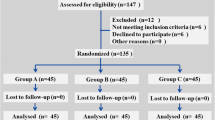Abstract
Computer-assisted surgery (CAS) in total knee arthroplasty (TKA) could be useful in reducing the overall blood loss. A prospective randomised study was performed with two groups of 50 patients each of whom were treated for knee arthritis. Patients of group A were treated by a conventional standard procedure, while for patients of group B a specific CAS procedure was used. We determined the intraoperative blood loss according to the Orthopaedic Surgery Transfusion Haemoglobin European Overview (OSTHEO) study. The average blood loss in patients of group A was 1,974 ml (range: 450–3,930 ml) compared to 1,677 ml of patients of group B (range: 500–2,634 ml). A statistically significant difference was found between the two groups (p = 0.0283). Computer-assisted surgery is highly recommended in TKR to save blood. It creates more possibilities to operate on anaemic patients and subjects who cannot accept blood products by reducing blood loss risk.
Résumé
La chirurgie assistée par ordinateur dans les prothèses totales du genou peut être utile afin de réduire les pertes sanguines. Matériel et méthode: une étude prospective, randomisée, a été réalisée avec deux groupes de 50 patients, chacun, traités pour une arthrose du genou. Les patients du groupe A ont été opérés sur un mode conventionnel alors que l’autre groupe l’a été avec assistance informatique dans le cadre de la navigation. Nous avons déterminé les perte sanguines per-opératoires selon l’évaluation OSTEO. Résultats: le total des pertes sanguines du groupe A a été de 1974 ml en moyenne (de 450 à 3930) en comparaison des 1677 ml des patients du groupe B (de 500 à 2634 ml). La différence est statistiquement significative entre les deux groupes, p = 0,0283). Conclusion: la navigation avec chirurgie assistée par ordinateur est recommandée pour les prothèses de remplacement articulaire afin de réduire les pertes sanguines. Cette technique donne plus de possibilité pour opérer les sujets anémiques qui ne peuvent supporter de grosses pertes sanguines.


Similar content being viewed by others
References
Chauhan SK, Scott RG, Breidahl W, Beaver RJ (2004) Computer-assisted knee arthroplasty versus a conventional jig-based technique. A randomised, prospective trial. J Bone Joint Surg Br 86:372–377
Chin PK, Yang KY, Yeo SJ, Lo NN (2005) Randomized control trial comparing radiographic total knee arthroplasty implant placement using computer navigation versus conventional technique. J Arthroplasty 20(5):618–626
Davies BL, Harris SJ, Lin WJ, Hibberd RD, Middleton R, Cobb JC (1997) Active compliance in robotic surgery—the use of force control as a dynamic constraint. Proc Inst Mech Eng [H] 211:285–292
Gross JB (1983) Estimating allowable blood loss: corrected for dilution. Anesthesiology 58:277–280
Kalairajah Y, Simpson D, Cossey AJ, Verral GM, Spriggins AJ (2005) Blood loss after total knee replacement: effects of computer-assisted surgery. J Bone Joint Surg Br 87:1480–1482
Ko PS, Tio MK, Tang YK, Tsang WL, Lam JJ (2003) Sealing the intramedullary femoral canal with autologous bone plug in total knee arthroplasty. J Arthroplasty 18:6–9
Kumar N, Saleh J, Gardiner E, Devadoss VG, Howell FR (2000) Plugging the intramedullary canal of the femur in total knee arthroplasty. J Arthroplasty 15:947–949
Lemos MJ, Healy WL (1996) Blood transfusion in orthopaedic operations. J Bone Joint Surg Am 78:1260–1271
Lotke PA, Faralli VJ, Orenstein EM, Ecker ML (1991) Blood loss after total knee replacement. Effects of tourniquet release and continuous passive motion. J Bone Joint Surg Am 73(7):1037–1040
Ong SM, Taylor GJ (2003) Can knee position save blood following total knee replacement? Knee 10(1):81–85
Raut VV, Stone MH, Wroblewski BM (1993) Reduction of postoperative blood loss after press-fit condylar knee arthroplasty with use of a femoral intramedullary plug. J Bone Joint Surg Am 75:1356–1357
Repicci JA, Eberle RW (1999) Minimally invasive surgical technique for unicondylar knee arthroplasty. J South Orthop Assoc 8:20–27
Rosencher N, Kerkkamp HEM, Macheras G, Munuera LM, Menichella G, Barton DM, Cremers S, Abraham IL (2003) Orthopedic Surgery Transfusion Hemoglobin European Overview (OSTHEO) study: blood management in elective knee and hip arthroplasty in Europe. Transfusion 43:459–469
Samama CM (2004) A direct antifibrinolytic agent in major orthopedic surgery. Orthopedics 27(6 Suppl):s675–s680
Sehat KR, Evans R, Newman JH (2000) How much blood is really lost in total knee arthroplasty? Correct blood loss management should take hidden loss into account. Knee 7(3):151–155
Sparmann M, Wolke B, Czupalla H, Banzer D, Zink A (2003) Positioning of total knee arthroplasty with and without navigation support. A prospective, randomised study. J Bone Joint Surg Br 85:830–835
Speck M, Jakob R et al (1999) Blood loss after total knee arthroplasty in relation to positioning: 70° flexion v extension. J Bone Joint Surg Br 81(Suppl 11):245
Stulberg SD, Picard F, Saragaglia D (2000) Computer-assisted total knee replacement arthroplasty. Oper Tech Orthop 10:25–39
Stulberg SD (2003) How accurate is current TKR instrumentation? Clin Orthop Relat Res 416:177–184
Tria AJ Jr, Coon TM (2003) Minimal incision total knee arthroplasty: early experience. Clin Orthop Relat Res 416:185–190
Vandenbussche E, Duranthon L, Couturier M, Pidhorz L, Augereau B (2002) The effect of tourniquet use in total knee arthroplasty. Int Orthop 26(5):306–309
Acknowledgement
Special thanks to Serena Arima, Maria Brigida Ferraro and Stefania Gubbiotti of Dipartimento di Statistica Probabilità e Statistiche Applicate Università di Roma “La Sapienza”.
Author information
Authors and Affiliations
Corresponding author
Rights and permissions
About this article
Cite this article
Conteduca, F., Massai, F., Iorio, R. et al. Blood loss in computer-assisted mobile bearing total knee arthroplasty. A comparison of computer-assisted surgery with a conventional technique. International Orthopaedics (SICOT) 33, 1609–1613 (2009). https://doi.org/10.1007/s00264-008-0651-7
Received:
Accepted:
Published:
Issue Date:
DOI: https://doi.org/10.1007/s00264-008-0651-7




